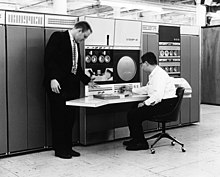







Programmed Data Processor (PDP), referred to by some customers, media and authors as "Programmable Data Processor,"[1][2][3] is a term used by the Digital Equipment Corporation from 1957 to 1990 for several lines of minicomputers.[4]
The name 'PDP' intentionally avoids the use of the term 'computer'. At the time of the first PDPs, computers had a reputation of being large, complicated, and expensive machines. The venture capitalists behind Digital (especially Georges Doriot) would not support Digital's attempting to build a 'computer' and the term 'minicomputer' had not yet been coined.[5][6] So instead, Digital used their existing line of logic modules to build a Programmed Data Processor and aimed it at a market that could not afford the larger computers.
The various PDP machines can generally be grouped into families based on word length.
- ^ Montgomery, H. E.; Uccellini, L. W. (October 1985). "VAS Demonstration" (PDF). nasa.gov.
- ^ "New Market Disruption: The DEC Programmable Data Processor". harvard.edu. Archived from the original on 2017-09-15.
- ^ R Belcher (2013). Computers in Analytical Chemistry. p. 153. ISBN 978-1483285627. "The term PDP is an acronym for Programmable Data Processor ... the series was introduced by their manufacturer, Digital Equipment Corporation ..."
- ^ "The History of Digital Equipment Corporation".
- ^ Henderson, Rebecca M.; Newell, Richard G., eds. (2011). Accelerating energy innovation : insights from multiple sectors. Chicago: University of Chicago Press. p. 180. ISBN 978-0226326832.
- ^ Huang, Han-Way (2014). The atmel AVR microcontroller : MEGA and XMEGA in assembly and C. Australia ; United Kingdom: Delmar Cengage Learning. p. 4. ISBN 978-1133607298.